The Race of the Centuries: 2013 Tesla Model S vs. 1915 Ford Model T

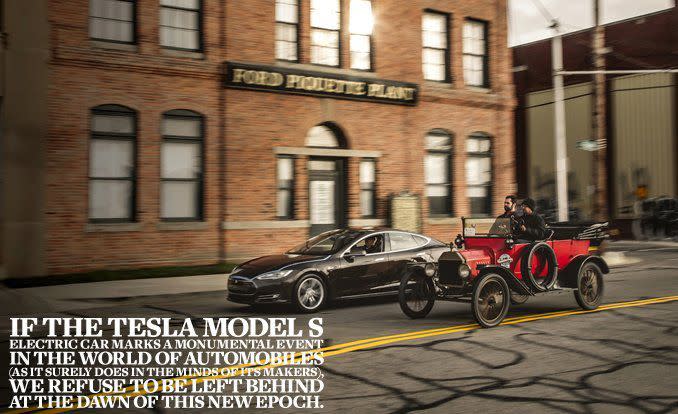
From the February 2014 Issue of Car and Driver
TESTED
A century from now, let no man or robot or digital personal companion embedded in the cerebellum at birth say that Car and Driver didn’t look at this thing from every possible angle.
Thus, we proceed with yet another trial of the Model S. This time we compare the electric car to its direct predecessor, the hydrocarbon-burning automobile, much as our forebears must have compared the first motorcar to the trusty nag, which was soon to be advertised with hefty cash rebates and complimentary oat bags.
So as not to be seen as blithely unappreciative of a new technology’s inevitable teething issues, namely the Tesla’s limited driving range and the nation’s inadequate charging infrastructure, we developed a kind of handicap for the Model S. The Tesla would not go up against a new car, which would enjoy a de facto head start thanks to more than a century of development. Instead, it would compete against a car more in line with an electric vehicle’s limitations. Hence, we looked back over automotive history for a suitable candidate. Way back, in fact. Actually, a bit further, and further still, and keep it going, just a little ways more . . . until we pretty much bumped into the horse again.
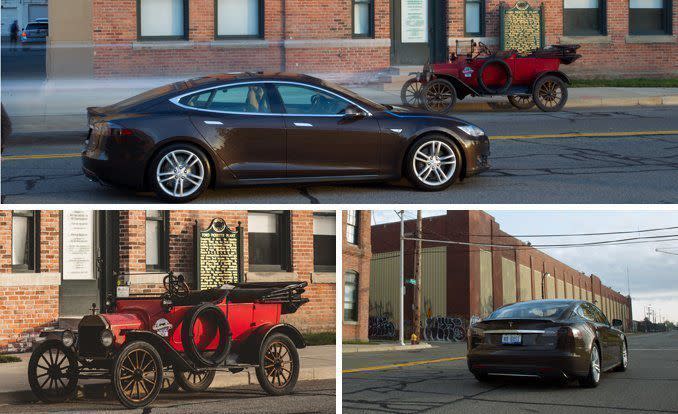
How would the car that’s heralded as the savior of humanity stack up against the humble Tin Lizzie?
Now, racing a 99-year-old Ford Model T against a new Tesla Model S across one-fifth of America is, really, in no way fair to either car. Neither was designed to be a continent crosser. At the time of our race, the number of Tesla’s high-power, quick-charge Supercharger stations in our area of the country was zero. And the number of people who could re-babbitt a Model T’s bearings probably rounded to zilch. While the Model T was undoubtedly the single greatest catalyst for the motor-vehicle infrastructure we now take for granted, it is also woefully, dangerously obsolete. Even the flow of suburban or country main streets is too fast for this 40-mph buggy. Every new car is endowed with a level of power and braking ability that leaves the T, which would prefer to just putter into town with this season’s prize-winning pumpkin in back, terrifyingly out of step.
• Follow Car and Driver on Facebook
Would there be blood? With any luck, no. But there might be chaos, and almost certainly frostbite.
We would start at the Model T Automotive Heritage Complex on Detroit’s Piquette Street, where the T was designed and first built. The red-brick, New England mill–style building erected in 1904 survives as a museum staffed by knowledgeable mavens who know the correct ways to apply lapping compound and petcock sealant.
With Tesla’s Fremont, California, assembly plant being much too far away, the finish line would instead be electrical pioneer Nikola Tesla’s old Wardenclyffe laboratory in Shoreham, New York, on Long Island. The lab, which opened in 1902, is itself in the process of becoming a museum. Depending on the route each team chose, the race course could be as short as 682 miles but long enough that the Tesla would need to charge several times. The T drivers would most likely have to apply at least some petcock sealant.

Each team determined its own route, using the same start and finish lines. Both cars would have to be driven the entire distance, and each team was assigned a chase truck for spares and the haul home. But there weren’t any other rules because Tesla team leader Don Sherman would just cheat anyway. The first car to Wardenclyffe would win immortality in this magazine, copies of which do, after all, go into the Library of Congress, where they’re left in the restrooms for anyone to read.
6 WEEKS prior to race
MODEL S TEAM: Crack mathematician Jessica Glomb of Battle Creek, Michigan, sits down at her kitchen table to predict a winner. Factoring in everything she knows (or can find on Wikipedia) about the Ford Model T and everything she knows about her father’s Tesla Model S, she concludes the following: The T will beat the S by one hour.
4 WEEKS UNTIL THE START
MODEL T TEAM: Given that few presently on staff at Car and Driver have ever driven a Model T, the Ford team needs help. It needs a ringer if it is going to make it through the 765 miles of two-laners from Detroit to Long Island. It also needs a Model T. David Liepelt, a 40-year-old man who is perpetually coated in a layer of motor oil, grease, and gasoline, is the best ringer one could hope for. Three T experts in three different states all independently direct us to Liepelt and the red 1915 T he’s owned for half his life. He was, for almost a decade, tasked with keeping a fleet of Ts running for the tourists at Henry Ford’s paean to the past, Greenfield Village in Dearborn, Michigan. Liepelt now works on steam locomotives. He is a man of the Industrial Age. He doesn’t own a television. He, along with his friend and fellow T owner Chris Paulsen, will be the core of the driving team. Our man, Daniel Pund, will perform the role of ballast and liability.
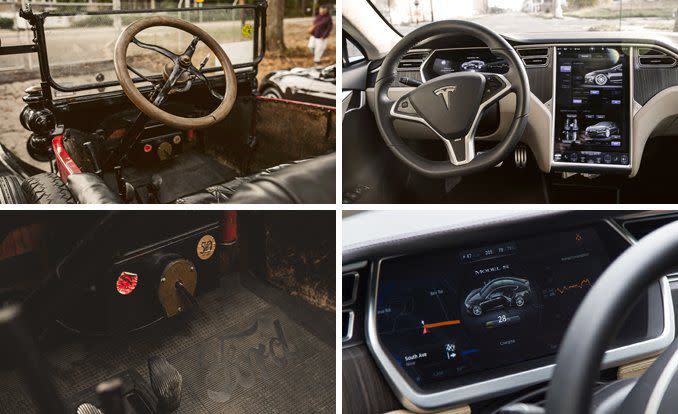
3 WEEKS TO GRID
MODEL S TEAM: Our strategy hinges on two simple data points, the 211-mile range C/D recorded during our road test of the Model S and the 682 MapQuest miles separating the start from the finish. Jessica’s father, Fred Glomb, 50, a man of the Information Age and owner of a technology-consulting firm, has volunteered his chocolate-brown Model S after seeing our petition for assistance on a Tesla owners message board. His car is ideal because he purchased it with the P85 Performance equipment, which includes the largest-available 85-kWh battery and the dual onboard chargers that would give us a chance at beating the T back to the Brass Era.
We must find two recharging stops both near our direct route and spaced every 230 or so miles between Detroit and Shoreham. Further, they must deliver 240 volts at 80 amps of charging power, like the Tesla High Power Wall Connector (HPWC) that Glomb has in his own garage. Simple. None of the existing Tesla Supercharger stations, which offer 75-minute recharges, are close to our route. So we start investigating potential charging locations, both commercial and private. We use PlugShare, a website and app that lists kindred spirits willing to share their electricity [see sidebar], but not all chargers are created equal. Finding a high-voltage unit with the necessary amperage is challenging.
With preparation time dwindling, we still haven’t nailed down a suitable second charging stop. We find Tesla Roadster owners and solar enthusiasts Mark Doncheski and Mary Hermann in Danville, Pennsylvania, but their existing charger isn’t compatible with the Model S. After cajoling the couple for access to their 100-amp utility pole, we hire electrician David Hayes to install the $1200 HPWC that we have shipped in. Later, we’ll figure out how to bury it in the ol’ expense account.
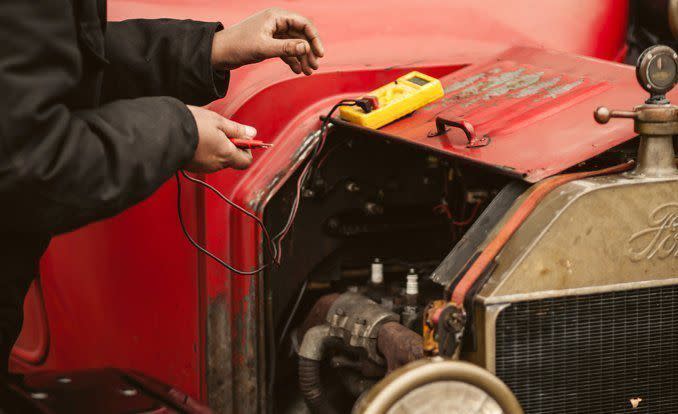
2 WEEKS TO ENGINE START
VOICE MAIL OF MODEL T TEAM LEADER DANIEL PUND: Daniel Pund is out of the office at the moment. If you’d like to leave a message, please press 1.
10 DAYS UNTIL GREEN
MODEL S TEAM: To avoid surprises and check on our handyman work, we reconnoiter two-thirds of the route. On this pre-run, we fine-tune our speed-versus-range variables, finding that the ideal cruising speed depends on terrain. We verify that both charge points can replenish a sapped battery pack in about five hours. This preparation also raises our familiarity with the route, diminishing the chance of a time- and energy-wasting off-course deviation. It is either this or force the Model S team members to catheterize themselves to eliminate the affront to efficiency that is the human waste system.
6 DAYS AND COUNTING
MODEL S TEAM: After consultations with Tire Rack for a low-rolling-resistance-tire recommendation, we mount a set of Michelin Primacy MXM4 radials with the tread rubber shaved to diminish energy-consuming squirm. Inflating the tires to 50 psi raises sidewall stiffness into the Cascade range. Wheel alignment is set to specs supplied by Tesla chassis experts. Everything nonessential—floor mats, gum wrappers, center-console lint—is swept from the Model S’s interior. We tape the front body seams to shave aerodynamic drag. We consider removing or folding the exterior mirrors but ultimately leave them deployed for safety’s sake.
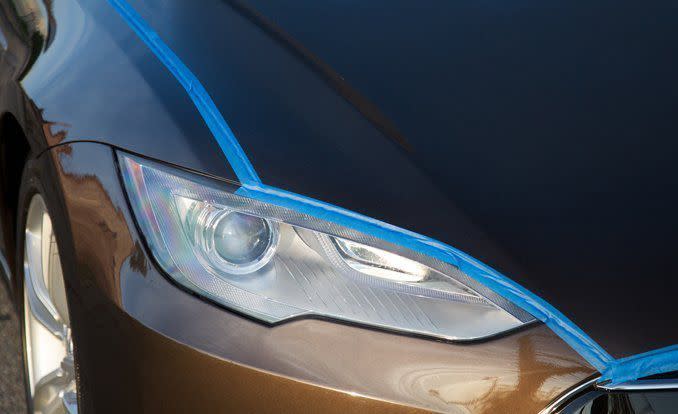
24 HOURS REMAINING
MODEL T TEAM LEADER PUND: It seems prudent, at this point, to get some seat time in a T, so I set out to learn how to drive the thing with Liepelt, in the countryside near his house. It goes well, meaning that I return from the experience only slightly more terrified of what we are about to embark on than I was before having actually driven the contraption I had incorrectly assumed was actually something resembling a car.
If you ask any surviving geezer what he thinks of the Ford Model T, he will likely have fond memories of it. Such is the appreciation for this icon of Yankee ingenuity, this wide-eyed, old-timey charmer. This is because the people who would have bad things to say about it all died in or under or within the general vicinity of a T.
Model Ts are simple devices. But then, so are machetes. When describing what sounds like minor mechanical mishaps in Model Ts, Liepelt is fond of saying things like, “By all rights, that guy should have lost a foot.” Lost a foot?! Who loses feet anymore?

9:17 A.M., TUESDAY, OCTOBER 15
MODEL T TEAM: We roar off on this chilly, gray October morning. Us and the non-roaring Model S. Actually, we don’t roar, either. It couldn’t have looked much like a race to the 10 or so bystanders, mostly Piquette museum volunteers and a couple of perplexed passersby. Okay, fine. With a subdued whine and a clatter, we roll off. Le Mans, this ain’t.
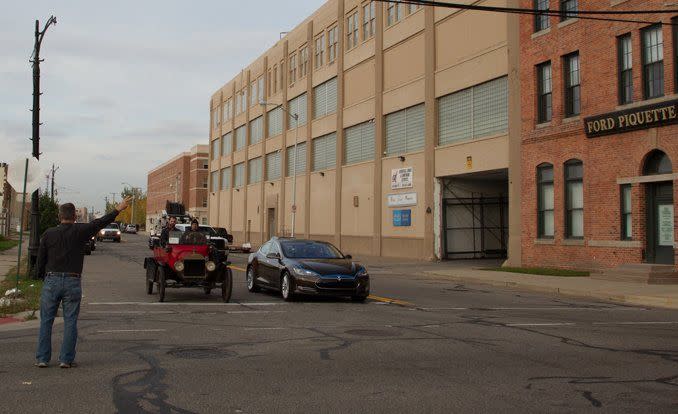
9:19 A.M., TUESDAY
MODEL S TEAM: Detroit races by in a blur as electrons spew from the Tesla’s batteries and go sluicing into the motor. We are winning already! Probably.
9:32 A.M., TUESDAY
MODEL T TEAM: Before the race, Liepelt assured us that a Model T doesn’t have the beans for expressway travel, so we planned to take less-speedy and much less direct roads to New York. Ford advertised a top speed of 40 mph for the 22-hp Model T. Our prohibition against expressways lasts all of 15 minutes before Liepelt wrestles the T onto the suburban Southfield Freeway and proceeds to crank along at a rate that, while sitting atop the high-mounted park bench of a seat with no belts and a gas tank directly underneath, feels entirely too fast. Later, we get a radio message from our chase truck that we hit 62 mph on a downhill grade. I holler over the wind to Liepelt, “You didn’t tell me this thing could do 62 mph!” His reply: “I didn’t know it could do 62 mph.” Instrumented testing later confirms Liepelt’s car to have a level-ground top speed of 55 mph.
1:10 P.M., TUESDAY
MODEL S TEAM: Car owner Glomb, at the wheel, breezes us out of Michigan and into Ohio flatlands at a steady 68 mph, arriving in Poland, Ohio, with 24 miles of range remaining.
1:12 P.M., TUESDAY
MODEL T TEAM: We are topping out at rates nearly 40 percent higher than the car’s supposed top speed, thanks largely to an aftermarket two-speed rear axle that somehow wasn’t mentioned in the pre-race meeting. This device adds a tall lever to the mix of the T’s already foreign controls. Model Ts have a two-speed planetary transmission operated by the left-most of three foot pedals. Reverse gear is engaged with the center foot pedal, and some minimal braking force is applied through the right pedal. The throttle is operated by a lever mounted on the right side of the steering column. Spark advance is controlled by a lever on the left-hand side of the column. I choose to ignore that one.

1:27 P.M., TUESDAY
MODEL S TEAM: Our first charging stop is at Lawless Industries, a shop only 10 miles off our ideal route. Tesla Motors had introduced us to Shawn Lawless, a member of the EV faithful whose enterprise builds state-of-the-art parade floats. Besides hot-rodding his own Model S, he constructs various electrically powered vehicles ranging from commercial lawn mowers to 177-mph drag bikes.
1:48 P.M., TUESDAY
MODEL T TEAM: Watching Liepelt or Paulsen get the T up to speed is like watching Willy Wonka operate a fantastical machine. It is a thing of studied beauty, a sequence of crazy motions accompanied by all manner of crunching, popping, and rumbling. I am less adept, and, once up to speed, simply hope to not have to stop. Despite the upgraded mechanical drum brakes Liepelt added to the rear years ago in a fit of sanity, the T doesn’t really brake so much as coast to an eventual standstill. In a standard T, the only thing that happens when you press the brake pedal is that a cotton-lined band in the transmission feebly squeezes a drum attached to the output shaft until you collide with whatever you were braking for.
2:02 P.M., TUESDAY
MODEL S TEAM: While our Model S sucks up 205 volts at 78 amps, our host whisks us to a nearby quarter-mile strip to see his electric dragster do a nearly silent disappearing act, turning in an 8.5-second, 145-mph run. Afterward, we have a relaxing lunch and take a short nap.

2:02 P.M., TUESDAY
MODEL T TEAM: On a farm road in Ohio we are passed by a scooter. I look over at Liepelt and say, “Dude, we just got passed by a scooter.” Liepelt, looking straight ahead, sighs, “Yep.”
2:14 P.M., TUESDAY
MODEL T TEAM: Driving a T is a distinctly outdoor experience. If it is cold outside, you will be cold. And you will remain so until you get into a building. The only heater is the drivetrain’s wasted BTUs, drifting up through the holes in the floor cut for the pedals. And we’re running with the two-piece windshield folded because our faces provide less wind resistance than a tall, flat piece of glass. But both the speed and the turn-of-the-century disregard for the softness of human flesh eventually are blown from my consciousness as we ramble through Ohio farmland.
It is during the long bucolic splendor and mercifully flat landscape of Ohio that we first check in on Sherman’s crew. A fortuitously placed brother-in-law who happens to be driving through Ohio confirms for us that the Tesla is not drafting behind some cobbled-up wind fairing mounted to its chase vehicle. Our spy also reports the Tesla’s speed to be about 65 mph. But alas, we already know that. The night before the start, our chase-truck driver, David Beard, a man whose great-grandmother was killed by a T, surreptitiously fastened a GPS tracker to the underside of the Tesla’s chase truck. This handy device, monitored on our smartphones, also serves to blunt what we assume is a text-message misinformation campaign being waged by the Tesla team.
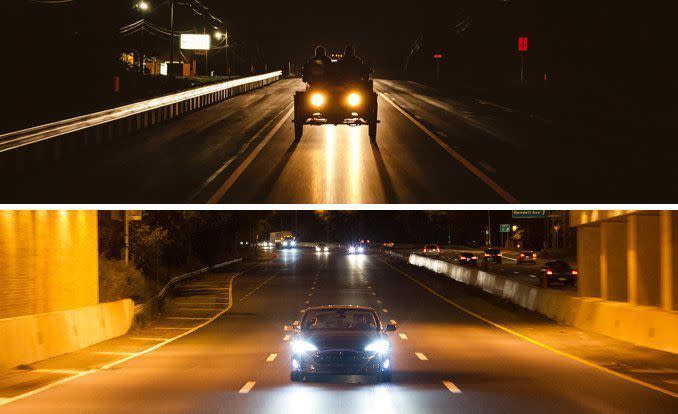
4:32 P.M., TUESDAY
MODEL T TEAM: We are barely across the Pennsylvania border before the T begins to sputter, backfire, and struggle going up hills. This is not as easy to recognize as you might imagine, because a T always struggles going up hills. Liepelt figures there must be dirt in the fuel system. He empties the cast-iron sediment bowl below the gas tank and pops the top off the aftermarket Rayfield carb. There is no obvious contamination, but without another solution, we decide this stop must have cured the problem and gamely pull back onto the road.
5:00 P.M., TUESDAY
MODEL T TEAM: Bang! Bang! Sputter. Turns out, wishful thinking is no substitute for a repair. Liepelt screws a new condenser onto his T’s Pinto-spec distributor (hey, at least it’s from a Ford), and we again choose to believe this will cure the T’s weak heart.
6:20 P.M., TUESDAY
MODEL T TEAM: Naturally, the fresh condenser doesn’t cure the problem. We roll to a stop at a Sheetz gas station in Kittanning, Pennsylvania. The name of the gas station roughly matches the words Liepelt is muttering from under the Model T. While he’s taking the carb completely apart, a gasket breaks. We have no replacement, and the car is now leaking fuel. We run across the street to the improbably named Dollar Horn (“Your Favorite Store!”) and wander around looking for something to seal the leak. We end up with a roll of cork and an assortment of rubber O-rings, profoundly confusing a couple of store employees. Since the carb has already been cobbled back together, we don’t want to risk taking it back apart. So we decide that one drip per second is maybe a safe leakage rate, and we fill up the tank. Beard eats a ham sandwich.
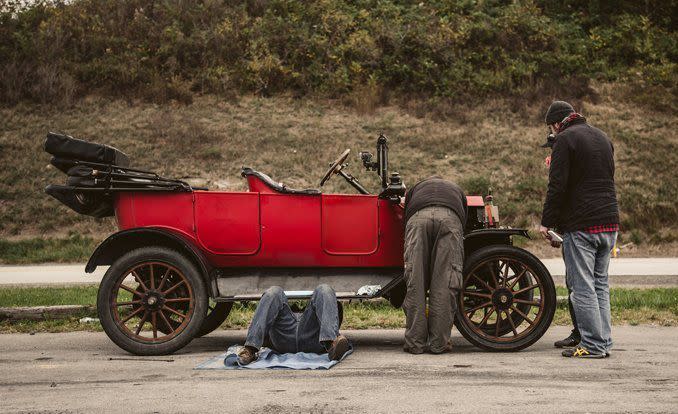
6:25 p.m., tuesday
MODEL S TEAM LEADER SHERMAN: Charging complete, I take over the Model S’s sumptuous driver’s seat for the second leg. The dash shows 270 miles of range available. Driving alone to limit ballast and, having disallowed the use of the climate-control system to save electrons, I am content to let the miles slip by peacefully.
7:45 P.m., tuesday
MODEL T TEAM: According to our GPS data, the Tesla has passed us somewhere around Clarion, Pennsylvania. This is not good news. The Model S has finished its first charge, and we have done a lot of standing around. Enthusiasm flags. Also, our battery is dead. It’s barely powerful enough to push light through the thick glass of the headlight lenses. Other drivers, our real nemeses throughout the trip, are charging up on us in the dark at a closing speed that spells certain dismemberment. We pull off and swap in a fresh battery that Liepelt has brought along. He’d feared that the car wouldn’t be able to keep the battery charged. We carry on, expecting to run out of electrical power in another hour. Beard comes up with the idea of charging the battery in the Ram chase truck for what we assume will be another short-order battery swap. We are aware of the painful irony: The Model T needs a battery swap, but the electric car does not.
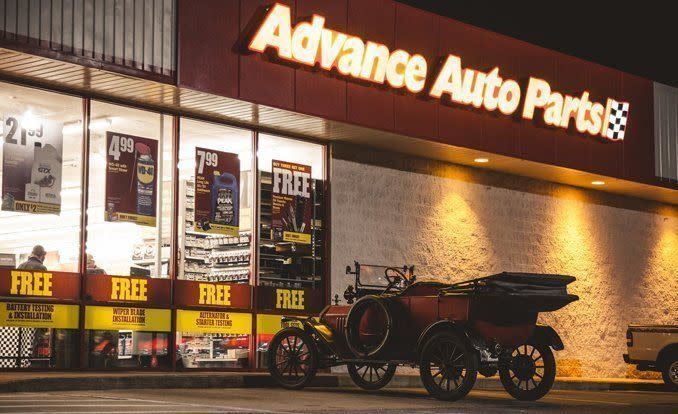
7:51 p.m., tuesday
MODEL S TEAM: Since my 251-mile stint includes Allegheny and Appalachian foothills, I have to drop below 60 mph to appease the battery gods. While you’re pitying the T crew, racing in the dead of a starless, chilly night in an open touring car from the Wilson administration, consider our plight. We have to accelerate with all the swiftness of erosion and cruise at less than half the Tesla’s 134-mph top speed as a train of semis whistles past.
8:29 p.m., tuesday
MODEL T TEAM: We stop at an Ebensburg, Pennsylvania, auto-parts shop and ask for the longest jumper cables they have. The guys behind the counter ask us what we’re up to. When we tell them, they ask us the same question again. Beard hefts the dead battery into the driver’s-side RamBox and tapes the jumper cables up over the cabin. We clip and tape one end to the Ram’s battery and the other to the battery out back. Voilà, a mobile charging station. An employee pops his head out the door and asks if we need anything before they close. “Probably” is the only response we can muster.
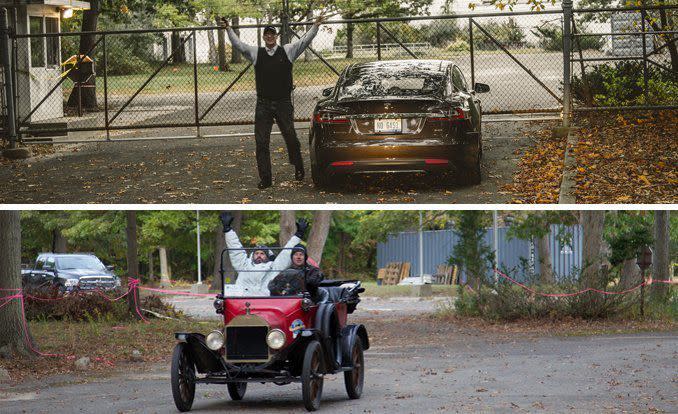
10:40 p.m., tuesday
MODEL S TEAM: The Doncheski-Hermann homestead is deep-space dark by the time we roll in with 25 miles of range remaining. While the Tesla draws 236 volts at 79 amps, Glomb and I sleep soundly in a warm motorhome.
middle of the night, tuesday, or maybe wednesday
MODEL T TEAM: Everything starts to blur together. Pennsylvania is an off-white smear of row houses sited close to the road, punctuated occasionally by glaring gas-station lights. Behind us, Beard can barely see out of the Ram’s windshield because it is coated in three quarts of 15/40 diesel motor oil that the T has been spitting since the start. It’s losing fluids quicker than we are.
Improbably, our battery holds strong and never needs another swap. And, more shocking, our sputtering problem evaporates. Liepelt reckons that it was caused by low fuel pressure and that keeping the tank as full as possible keeps the gravity-fed engine humming. We short-stint through the night, stopping every 60 or so miles to top off the tank. We have only the cold to contend with now. Well, that and fatigue, which is taking over from the face-blistering cold as our most immediate concern. I briefly fall asleep in the passenger seat of the T and awake with a start, realizing there is nothing to prevent me from falling out.
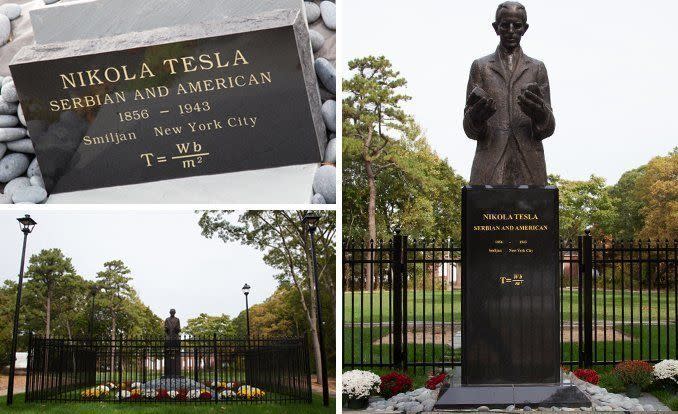
3:21 a.m., wednesday, october 16
MODEL S TEAM: With the car recharged, Glomb hustles the Tesla down the driveway, at least until we encounter two deer, which we shoo from our path.
5:38 a.m., wednesday
MODEL T TEAM: A dude walking out of a gas station in Dover, New Jersey, yells “Chitty, chitty, bang, bang! Where’d you find that thing? In a barn?” To this, Liepelt is gracious, noting that the T has been active in collector-car club events since the 1950s. The man responds, “Did you find it in a barn?”
6:06 a.m., wednesday
MODEL S TEAM: When we ask what part of the George Washington Bridge we just bought after paying $15 per axle in tolls for our six-axle convoy, the toll taker answers, “One light bulb.” During the sprint across Long Island, we scan side roads for the T. Satisfied we’re leading, Glomb indulges the accelerator.
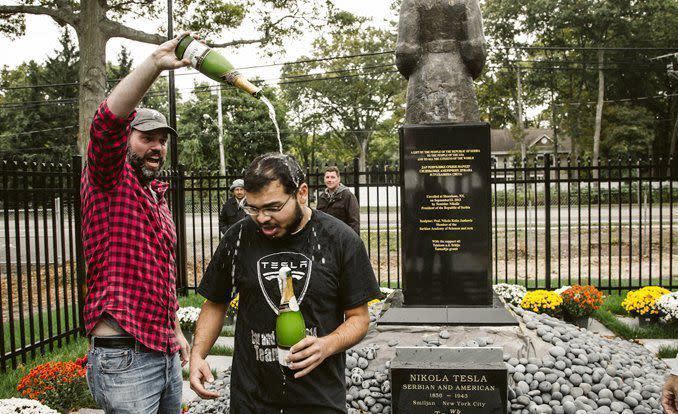
6:41 a.m., wednesday
MODEL T TEAM: We cross the George Washington Bridge at the beginning of rush hour. The toll attendant shows no reaction to our vehicle. Paulsen makes a masterful run through city traffic. The GPS transmitter on the enemy car is dead. It ran out of power sometime in the night. We know that Sherman’s team stopped for their second charge, and we know where. Beyond that, we know nothing.
A text from the Tesla team’s photographer notes that they are six miles from the end. We tell them that we are two miles from finishing in a last-ditch hope that they’ll blast through their range trying to catch us. But mostly just to make Sherman tense.
7:25 a.m., wednesday
MODEL S TEAM: After 22 hours and eight minutes on the road, we wheel the Model S up to the Tesla Science Center, our finish line. There are no brass bands, no curious media, and, most important, no crowing Model T troglodytes to greet us. The gate is padlocked, the birds are at peace, and for all we know, our rivals have thrown a petcock in Pennsylvania. The Tesla’s average speed for the trip is 32 mph or 58 mph minus the 10 hours of charging time.

8:35 a.m., wednesday
MODEL T TEAM: We pull into the Science Center windburned, red-eyed and packed with Fritos, Cajun-flavored peanuts, and beef jerky; we are in the state of calm that comes after being intensely tired for an absurdly long time. The tough old buggy made it, running nearly flat-out for 765 miles. We shake hands with the S team and head to a group breakfast in the T. The S sits charging on its electrical umbilical cord.
9:10 a.m., wednesday
MODEL S TEAM: Well, she might not have correctly predicted which team would win, but give Jessica Glomb credit for at least getting the winning margin right. Sadly, she’s absent for the high fives at Nikola’s old stomping grounds. Considering that a century of intensive development separates the Model S from the Model T, our winning margin is astoundingly small. But then, so is all human achievement when measured against the boundless infinity of the cosmos. Which is a lot bigger than the number of restroom stalls in the Library of Congress, so hurry it up, pal.
VehicleFord Model T
Click here to view test sheet.Tesla Model S
Click here to view test sheet.Base Price$440 (in 1915)$94,570Price as Tested$440 (in 1915)$105,470DimensionsLength134.5 inches196.0 inchesWidth66.0 inches77.3 inchesHeight82.0 inches56.5 inchesWheelbase100.0 inches116.5 inchesCurb Weight1802 lbs4785 lbs
PowertrainEngine/Motorflathead 8-valve inline-4, iron block and head, 1x1 bbl carburetor
AC permanent-magnet synchronous
Power HP @ RPM22 @ 1600416 @ 8600Torque LB-FT @ RPM83 @ 900443 @ 0DrivelineTransmission2-speed pedal-shifted1-speed direct drive
C/D Test
Results*Acceleration0–50 MPH26.3 sec3.6 sec0–60 MPH-4.6 sec0–100 MPHyeah, right12.1 sec¼-Mile @ MPH25.3 sec @ 4913.3 sec @ 104Top Speed55 mph (drag ltd)134 mph (gov ltd)Braking227 feet (50–0 mph)160 feet (70–0 mph)
*Tesla Model S Test Results from Instrumented Test published in our January 2013 issue.
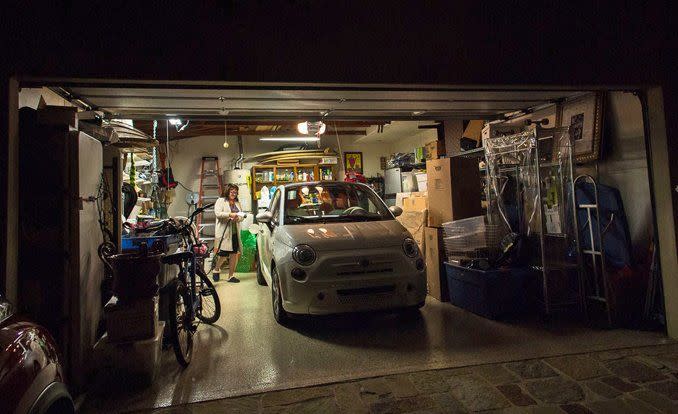
The Slow Fuel Movement
Driving from San Diego to San Francisco in an electric Fiat 500e is like using a Norelco to cut your lawn. An 85-mile range and a four-hour charging time make the 500-mile trip a near impossibility if you’re depending on public infrastructure. But there is another way: Download the PlugShare app, which maps charging stations, including those in the garages of your fellow Americans. More than 5800 people have added their homes to the nationwide database, inviting strangers to use their electricity and their toilets.
Many are in California. We found 65 in San Diego, including one at a bayfront beach house owned by Lew Mills, a clinical psychotherapist. When we called to invite ourselves over, he replied: “I’m having a party. I’ll put you on the guest list.”
Stopping to purchase a $28 bottle of rye, we were obeying not just party-going politesse, but also a convention of PlugSharing. This would-be utopian collective operates on a barter economy, such that private charging often ends up costing magnitudes more than the $2 you’d pay to charge at a commercial station. It’s designed to be used in emergencies, when there are no public stations available. Or for when you’re desperately lonely.
Mills barefooted out to hook up the Fiat in his garage and then invited us to revel. He said he shares his plug to help combat range anxiety, the electric car’s most pernicious foe.
The next day, 75 miles north in San Juan Capistrano, Judy Soroudi also invited us inside after plugging us in. “You shouldn’t have come to a Jewish mother’s house,” she said, “if you didn’t want chicken soup.”
After feeding us, she told a wistful story of giving a sea captain a ride to his regatta while his vehicle was charging. Chauffeuring visitors is commonplace among PlugSharers, out of kindness but also because it’s easier to drive someone 10 minutes down the road than to entertain them for hours while their car recharges. Soroudi said she had no qualms about inviting strangers into her house because “people who care about the environment are nice.”
Not that all PlugSharers are peaceniks or reek of patchouli. Dan Flaherty’s Annapolis ring glinted from the sunlight streaming into his Malibu home, where he offered coffee and bacon while the Fiat juiced up. The former fighter pilot and Harvard Business School–educated CFO told us that he signed up for PlugShare to usher in the future.
Eighty-five miles north in Santa Barbara, Jay Hennigan said that yes, his plug was available, but he pointed us to exactly that future in the form of a public charging station at a nearby bank. After experiencing the camaraderie of PlugSharing, charging there felt like being a fisherman eating canned tuna at sea.
Steve Scholpp’s house in Cambria was indispensable, as topping off the battery at his carport is the only way to make the 75 mountainous miles to Big Sur. Hypermiling through the Santa Lucia Mountains was like riding a very slow roller coaster. We chugged up the peaks at a range-maximizing pace slow enough to anger Winnebagos, and then regenerated into the valleys as if riding a one-car Space Mountain.
Farther up the coast, while we were charging at Will and Jill Beckett’s house in Santa Cruz, Jill made an observation about the world of EVs, which she described as “inhabited by nerds who only like to talk to each other about cars.” In their own way, EV drivers are every bit as enthusiastic as the guy who shows up at the Porsche Club dinner flying Martini colors. It is a tight cohort, implicitly trusting and almost tribal.
But the conditions that make this possible will not exist forever. As the public infrastructure gets built and electric cars become more widespread, the community will undoubtedly become diluted. This is PlugSharing’s summer of love.
—Robert Plotkin
You Might Also Like

 Yahoo Autos
Yahoo Autos 